check engine CHEVROLET KODIAK 2007 Owner's Manual
[x] Cancel search | Manufacturer: CHEVROLET, Model Year: 2007, Model line: KODIAK, Model: CHEVROLET KODIAK 2007Pages: 430, PDF Size: 6.06 MB
Page 179 of 430
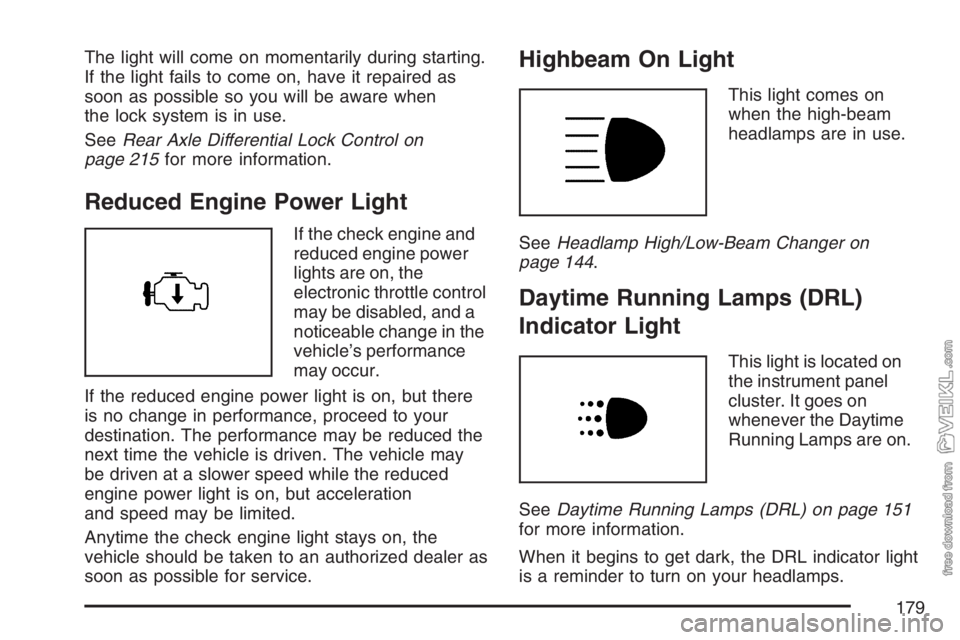
The light will come on momentarily during starting.
If the light fails to come on, have it repaired as
soon as possible so you will be aware when
the lock system is in use.
SeeRear Axle Differential Lock Control on
page 215for more information.
Reduced Engine Power Light
If the check engine and
reduced engine power
lights are on, the
electronic throttle control
may be disabled, and a
noticeable change in the
vehicle’s performance
may occur.
If the reduced engine power light is on, but there
is no change in performance, proceed to your
destination. The performance may be reduced the
next time the vehicle is driven. The vehicle may
be driven at a slower speed while the reduced
engine power light is on, but acceleration
and speed may be limited.
Anytime the check engine light stays on, the
vehicle should be taken to an authorized dealer as
soon as possible for service.
Highbeam On Light
This light comes on
when the high-beam
headlamps are in use.
SeeHeadlamp High/Low-Beam Changer on
page 144.
Daytime Running Lamps (DRL)
Indicator Light
This light is located on
the instrument panel
cluster. It goes on
whenever the Daytime
Running Lamps are on.
SeeDaytime Running Lamps (DRL) on page 151
for more information.
When it begins to get dark, the DRL indicator light
is a reminder to turn on your headlamps.
179
Page 180 of 430
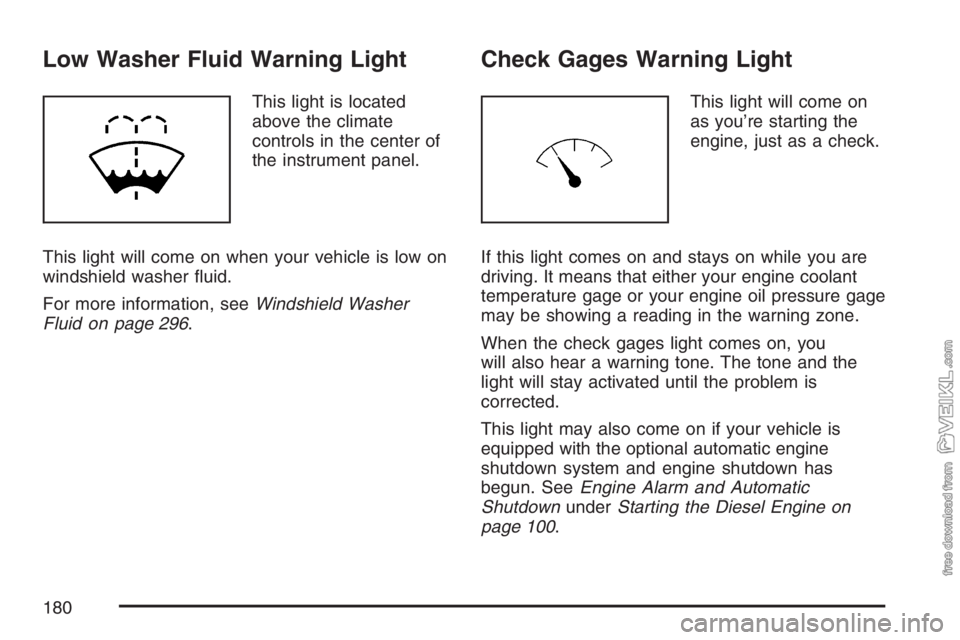
Low Washer Fluid Warning Light
This light is located
above the climate
controls in the center of
the instrument panel.
This light will come on when your vehicle is low on
windshield washer fluid.
For more information, seeWindshield Washer
Fluid on page 296.
Check Gages Warning Light
This light will come on
as you’re starting the
engine, just as a check.
If this light comes on and stays on while you are
driving. It means that either your engine coolant
temperature gage or your engine oil pressure gage
may be showing a reading in the warning zone.
When the check gages light comes on, you
will also hear a warning tone. The tone and the
light will stay activated until the problem is
corrected.
This light may also come on if your vehicle is
equipped with the optional automatic engine
shutdown system and engine shutdown has
begun. SeeEngine Alarm and Automatic
ShutdownunderStarting the Diesel Engine on
page 100.
180
Page 185 of 430

While your vehicle is parked:
•Familiarize yourself with all of its controls.
•Familiarize yourself with its operation.
•Set up your audio system by presetting your
favorite radio stations, setting the tone, and
adjusting the speakers. Then, when driving
conditions permit, you can tune to your favorite
radio stations using the presets and steering
wheel controls if the vehicle has them.
Notice:Before adding any sound equipment to
your vehicle, such as an audio system, CD
player, CB radio, mobile telephone, or two-way
radio, make sure that it can be added by
checking with your dealer. Also, check federal
rules covering mobile radio and telephone
units. If sound equipment can be added, it is
very important to do it properly. Added sound
equipment may interfere with the operation of
your vehicle’s engine, radio, or other systems,
and even damage them. Your vehicle’s systems
may interfere with the operation of sound
equipment that has been added.Notice:The chime signals related to safety
belts, parking brake, and other functions
of your vehicle operate through the
radio/entertainment system. If that equipment
is replaced or additional equipment is added
to your vehicle, the chimes may not work. Make
sure that replacement or additional equipment
is compatible with your vehicle before
installing it.
Setting the Time
Press and hold the HR (down) or MIN (up) arrow
for two seconds. Then press HR until the
correct hour appears on the display. Press and
hold MIN until the correct minute appears on
the display. The time can be set with the ignition
on or off.
185
Page 212 of 430
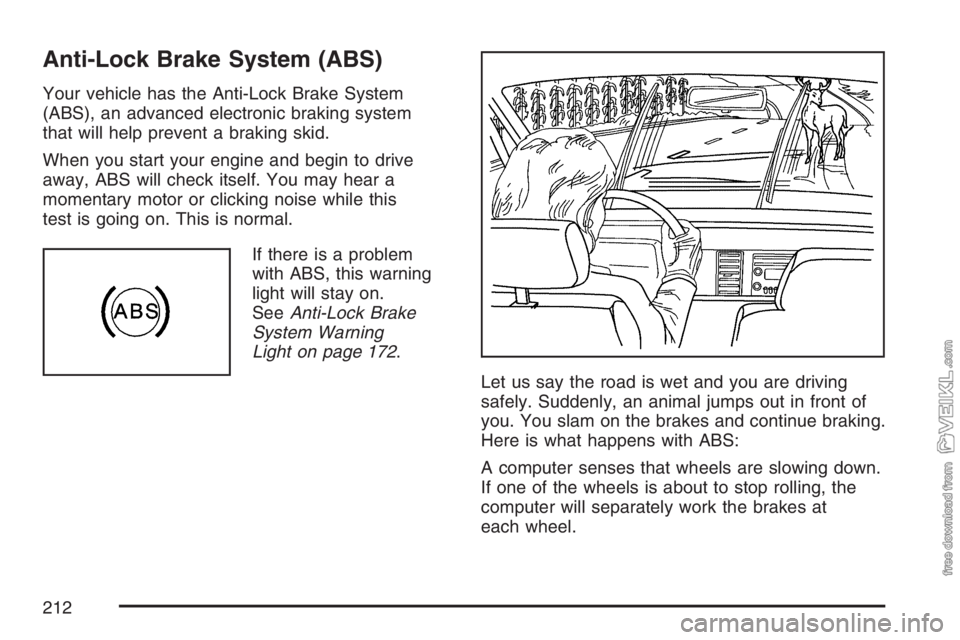
Anti-Lock Brake System (ABS)
Your vehicle has the Anti-Lock Brake System
(ABS), an advanced electronic braking system
that will help prevent a braking skid.
When you start your engine and begin to drive
away, ABS will check itself. You may hear a
momentary motor or clicking noise while this
test is going on. This is normal.
If there is a problem
with ABS, this warning
light will stay on.
SeeAnti-Lock Brake
System Warning
Light on page 172.
Let us say the road is wet and you are driving
safely. Suddenly, an animal jumps out in front of
you. You slam on the brakes and continue braking.
Here is what happens with ABS:
A computer senses that wheels are slowing down.
If one of the wheels is about to stop rolling, the
computer will separately work the brakes at
each wheel.
212
Page 229 of 430
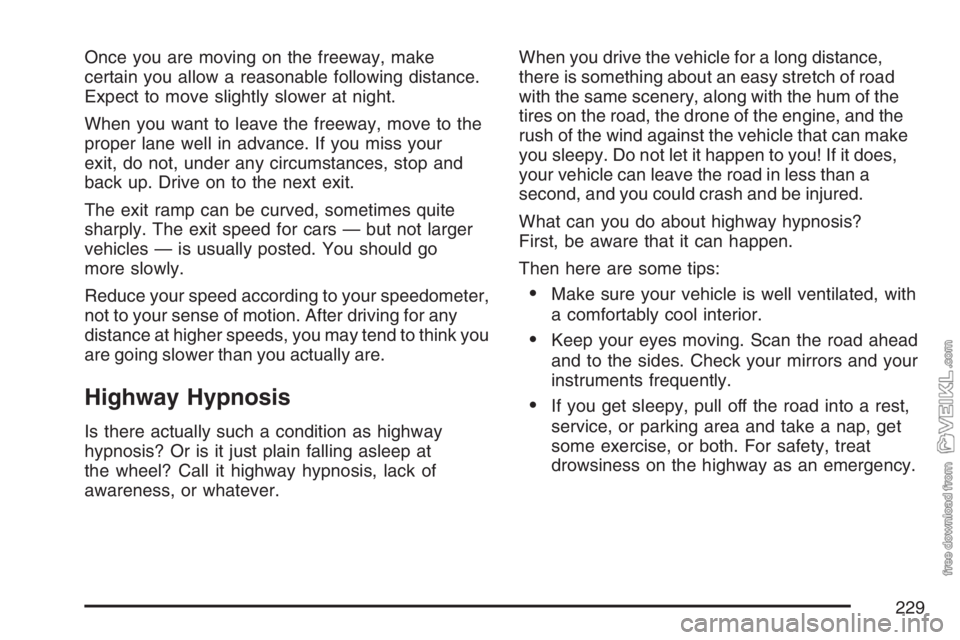
Once you are moving on the freeway, make
certain you allow a reasonable following distance.
Expect to move slightly slower at night.
When you want to leave the freeway, move to the
proper lane well in advance. If you miss your
exit, do not, under any circumstances, stop and
back up. Drive on to the next exit.
The exit ramp can be curved, sometimes quite
sharply. The exit speed for cars — but not larger
vehicles — is usually posted. You should go
more slowly.
Reduce your speed according to your speedometer,
not to your sense of motion. After driving for any
distance at higher speeds, you may tend to think you
are going slower than you actually are.
Highway Hypnosis
Is there actually such a condition as highway
hypnosis? Or is it just plain falling asleep at
the wheel? Call it highway hypnosis, lack of
awareness, or whatever.When you drive the vehicle for a long distance,
there is something about an easy stretch of road
with the same scenery, along with the hum of the
tires on the road, the drone of the engine, and the
rush of the wind against the vehicle that can make
you sleepy. Do not let it happen to you! If it does,
your vehicle can leave the road in less than a
second, and you could crash and be injured.
What can you do about highway hypnosis?
First, be aware that it can happen.
Then here are some tips:
•Make sure your vehicle is well ventilated, with
a comfortably cool interior.
•Keep your eyes moving. Scan the road ahead
and to the sides. Check your mirrors and your
instruments frequently.
•If you get sleepy, pull off the road into a rest,
service, or parking area and take a nap, get
some exercise, or both. For safety, treat
drowsiness on the highway as an emergency.
229
Page 230 of 430
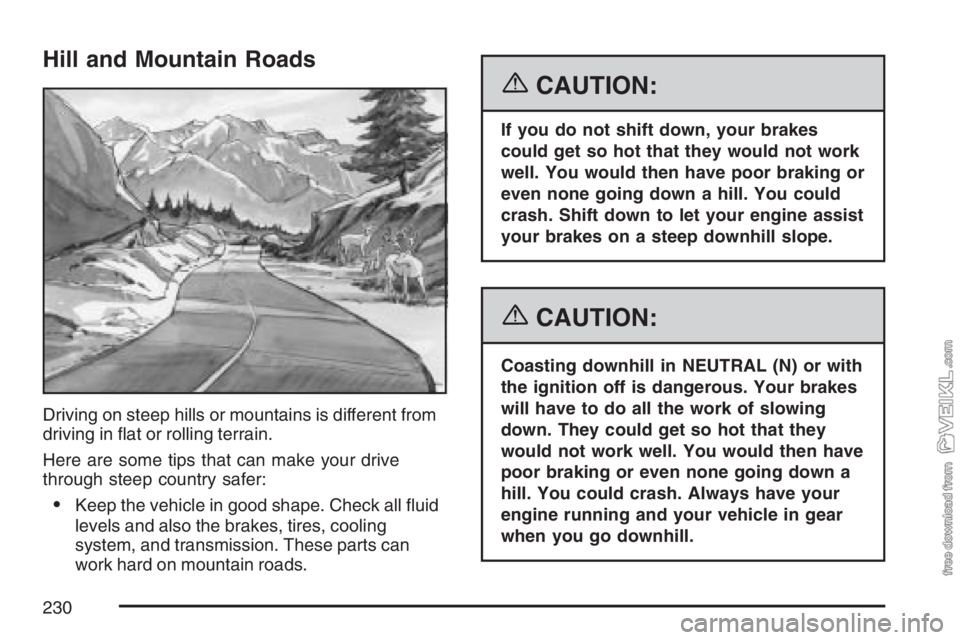
Hill and Mountain Roads
Driving on steep hills or mountains is different from
driving in flat or rolling terrain.
Here are some tips that can make your drive
through steep country safer:
•Keep the vehicle in good shape. Check all fluid
levels and also the brakes, tires, cooling
system, and transmission. These parts can
work hard on mountain roads.
{CAUTION:
If you do not shift down, your brakes
could get so hot that they would not work
well. You would then have poor braking or
even none going down a hill. You could
crash. Shift down to let your engine assist
your brakes on a steep downhill slope.
{CAUTION:
Coasting downhill in NEUTRAL (N) or with
the ignition off is dangerous. Your brakes
will have to do all the work of slowing
down. They could get so hot that they
would not work well. You would then have
poor braking or even none going down a
hill. You could crash. Always have your
engine running and your vehicle in gear
when you go downhill.
230
Page 235 of 430

{CAUTION:
Snow can trap exhaust gases under your
vehicle. This can cause deadly CO (carbon
monoxide) gas to get inside. CO could
overcome you and kill you. You cannot
see it or smell it, so you might not know it
is in your vehicle. Clear away snow from
around the base of your vehicle if any is
blocking your exhaust pipe. And check
around again from time to time to be sure
snow does not collect there.
Open a window just a little on the side of
the vehicle that is away from the wind.
This will help keep CO out.Run your engine only as long as you must. This
saves fuel. When you run the engine, make it
go a little faster than just idle. That is, push the
accelerator slightly. This uses less fuel for the heat
that you get and it keeps the battery (or batteries)
charged. You will need a well-charged battery (or
batteries) to restart the vehicle, and possibly for
signaling later on with your headlamps. Let the
heater run for a while.
If you have a diesel engine, you may have to run
it at a higher speed to get enough heat.
Then, shut the engine off and close the window
almost all the way to preserve the heat. Start
the engine again and repeat this only when you
feel really uncomfortable from the cold. But do it
as little as possible. Preserve the fuel as long
as you can. To help keep warm, you can get
out of the vehicle and do some fairly vigorous
exercises every half hour or so until help comes.
235
Page 245 of 430
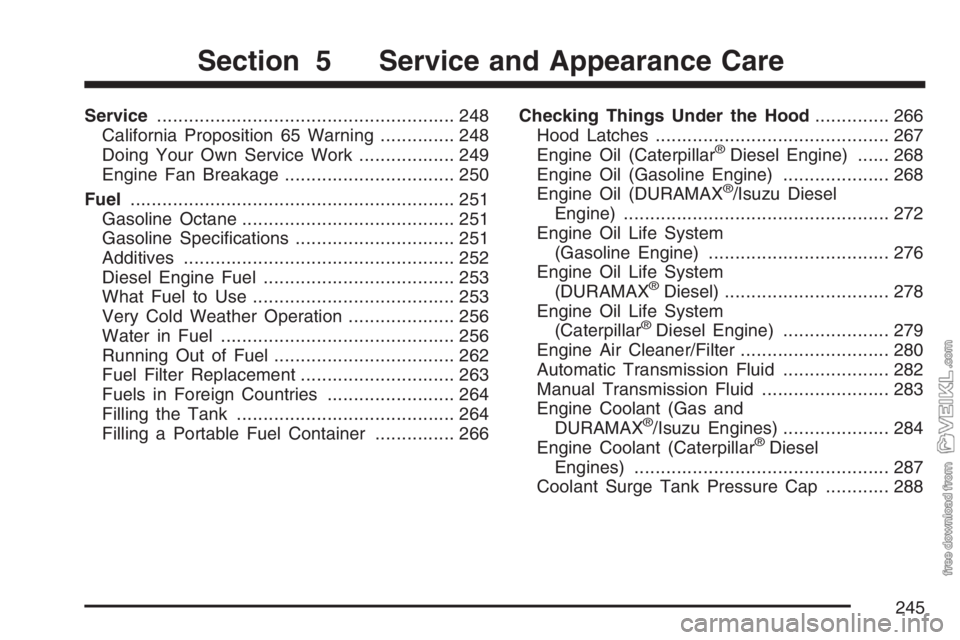
Service........................................................ 248
California Proposition 65 Warning.............. 248
Doing Your Own Service Work.................. 249
Engine Fan Breakage................................ 250
Fuel............................................................. 251
Gasoline Octane........................................ 251
Gasoline Specifications.............................. 251
Additives................................................... 252
Diesel Engine Fuel.................................... 253
What Fuel to Use...................................... 253
Very Cold Weather Operation.................... 256
Water in Fuel............................................ 256
Running Out of Fuel.................................. 262
Fuel Filter Replacement............................. 263
Fuels in Foreign Countries........................ 264
Filling the Tank......................................... 264
Filling a Portable Fuel Container............... 266Checking Things Under the Hood.............. 266
Hood Latches............................................ 267
Engine Oil (Caterpillar
®Diesel Engine)...... 268
Engine Oil (Gasoline Engine).................... 268
Engine Oil (DURAMAX
®/Isuzu Diesel
Engine).................................................. 272
Engine Oil Life System
(Gasoline Engine).................................. 276
Engine Oil Life System
(DURAMAX
®Diesel)............................... 278
Engine Oil Life System
(Caterpillar
®Diesel Engine).................... 279
Engine Air Cleaner/Filter............................ 280
Automatic Transmission Fluid.................... 282
Manual Transmission Fluid........................ 283
Engine Coolant (Gas and
DURAMAX
®/Isuzu Engines).................... 284
Engine Coolant (Caterpillar®Diesel
Engines)................................................ 287
Coolant Surge Tank Pressure Cap............ 288
Section 5 Service and Appearance Care
245
Page 260 of 430
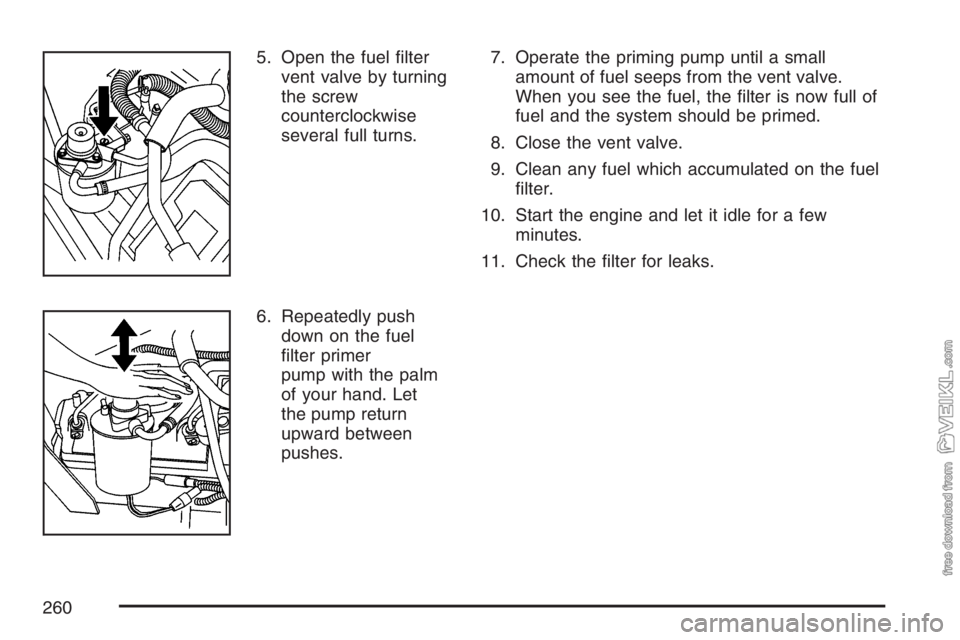
5. Open the fuel filter
vent valve by turning
the screw
counterclockwise
several full turns.
6. Repeatedly push
down on the fuel
filter primer
pump with the palm
of your hand. Let
the pump return
upward between
pushes.7. Operate the priming pump until a small
amount of fuel seeps from the vent valve.
When you see the fuel, the filter is now full of
fuel and the system should be primed.
8. Close the vent valve.
9. Clean any fuel which accumulated on the fuel
filter.
10. Start the engine and let it idle for a few
minutes.
11. Check the filter for leaks.
260
Page 261 of 430

Priming the 7.8L Isuzu 6H Diesel Engine
If your vehicle is equipped with the 7.8L Isuzu 6H
diesel engine, use the following procedure to
prime the engine:
1. Make sure there is fuel in the fuel tank.
2. Make sure the specified fuel filter is properly
installed.
3. Make sure the fuel lines are securely
connected.
4. Make sure the fuel filter is cool to the touch.
5. Use a clean cloth to remove dirt and oil
from the fuel filter head and breather valve.6. Use the palm of your hand to repeatedly
press and release the plunger (1) at the
top of the fuel filter priming pump. Continue
until the plunger resistance becomes firm. This
may take from 20 to 100 times, depending
upon fuel tank location.
7. Turn the fuel filter breather valve screw (2)
counterclockwise several turns to open the
breather valve.
8. Use the palm of your hand to repeatedly
press and release the plunger (1) at the
top of the fuel filter priming pump until fuel
begins to seep from the breather valve.
9. Tighten the fuel filter breather screw (2) to the
specified torque, 4.9
Y(43 in. lbs).
10. Use the palm of your hand to press and
release the plunger (1) at the top of the
fuel filter priming pump about 20 more times.
This sends fuel to the engine.
11. Use a clean cloth to remove any fuel from the
fuel filter and surrounding area.
12. Start the engine and allow it to idle for a
few minutes.
13. Check the fuel filter for leakage.
261